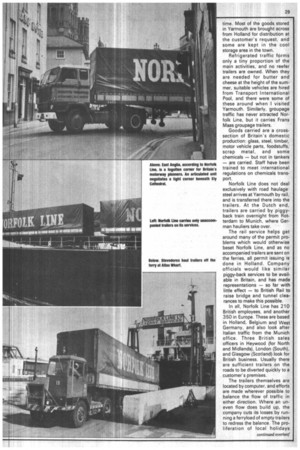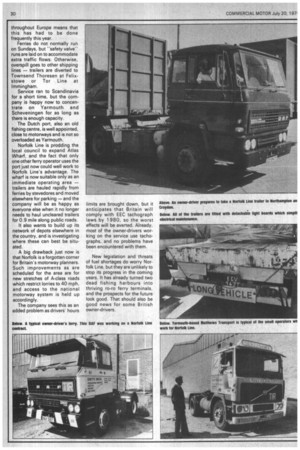Dying port gets injection of life
Page 30

Page 31

Page 32

If you've noticed an error in this article please click here to report it so we can fix it.
Great Yarmouth is back on the map again after slumbering in decline since the Middle Ages. Once again its trade with the Continent-but now by ro-ro femes. Alan Millar reports. Pictures by Brian Weatherley
IF I WAS asked to recite a list of this country's roll-on/roll-off ferry ports, I suspect I might well miss out Great Yarmouth. It is in the heart of bed and breakfast and kipper country, yet it is also the British end of a ro-ro trailer operation which has grown tenfold over the last decade, and which is still pushing up.
Norfolk Line, an Anglo-Dutch company owned by Unilever for the last six years runs three freight ferries between the Norfolk port and Scheveningen in Holland every weekday, and has a road operation at each end which deserves study in itself. Indeed, the company realises that operators would be reluctant to use Yarmouth unless it ran a fully integrated service of trailers, ferries, warehousing, distribution, and customs clearance.
The company boasts that it is a haulier, not just a shipping line. "As far as we are concerned, if there wasn't any water in between, we would drive all the way across to Holland,I was told.
The ferries, The Duke of Holland, Duke of Norfolk, and Duchess of Holland, work in conjunction with a fleet of 1000 trailers which run from points throughout the British mainland to Holland, Belgium, West Germany, Switzerland, and Austria. Traffic also goes to Italy, Yugoslavia, and Bulgaria when loads are available, but the ferry route rules out French and Scandinavian business.
When the ro-ro service began in January 1969, Norfolk Line had only one ferry and 100 trailers, and the company's Atlas Wharf at Yarmouth was only a fraction of its present size. Now the site is bursting at the seams, and the company uses several sites around the town for overflow parking and light maintenance. It is working on plans to redevelop parts of the wharf which have been vacated by the dying North Sea fishing industry.
Norfolk Line's road operation stands apart from many others. It operates only 14 tractive units, and these are connected to the warehousing and distribution side of the business. The rest of the British trunk haulage is in the hands of 52 hauliers, most of them small, and many of them owner-drivers who operate almost as if they are employees of the shipping line.
The company did not want to set up its own transport section in 1969, and courted the local owner-drivers, some of whom have grown up with the shipping service. Yarmouth-based Trevor Matthews, for instance, started with his own lorry and now trades as the five-vehicle Matthews Group. All but two of the 52 hauliers have between one and five vehicles.
They work exclusively for Norfolk Line, which makes all other arrangements for collection and delivery of loads throughout the country. Backloads are usually available, but Norfolk Line, rather than the haulier, loses out when none is available, and the haulier charges for the amount of mileage covered..
The Dutch-built 12m flatbed and curtain-sided trailers are all maintained in Holland, but running repairs to meet immediate needs are carried out at Yarmouth, Tyres are a major item for this aspect of maintenance, and haulage drivers are given an opportunity to check the trailer's condition before setting out.
Norfolk Line sought out hauliers when it started the service, but now hauliers themselves sell their services to the company. Like any local business community, there is a "bush teleghraph" communication network among the East Anglian hauliers with whom Norfolk Line deals, and this serves as an ideal monitor of new firms' standing.
In any case, it says that there is no problem in dealing with companies which are not bona. fide, as police can descend rapidly upon them. The lack of escape routes from Yarmouth means that lorries are compelled to leave the area either through Norwich or Lowestoft.
The 14 Volvo F86 and F7 tractive units owned by the company were chosen because pf their power-to-weight ratio which works best within the present 32-ton limit. It will probably move up to F10 or F12 models if and when British limits are raised, and already its trailers are built to 38-tonne standards, It uses the F7-to-F10 example as an argument in favour of a higher maximum, saying that it will mean better rather than bigger vehicles, and points out that operation will be made simpler. At present, three tons of cargo sometimes has to be removed from an overweight lorry and sent a few days later through the company's distribution system.
The warehousing and distribution service is geared mainly to handling canned food, although Yugoslavia-bound Scotch whisky was handled for a time. Most of the goods stored in Yarmouth are brought across from Holland for distribution at the customer's request, and some are kept in the cool storage area in the town.
Refrigerated traffic forms only a tiny proportion of the main activities, and no reefer trailers are owned. When they are needed for butter and cheese at the height of the summer, suitable vehicles are hired from Transport International Pool, and there were some of these around when I visited Yarmouth. Similarly, groupage traffic has never attracted Norfolk Line, but it carries Frans Maas groupage trailers.
Goods carried are a crosssection of Britain's domestic production: glass, steel, timber, motor vehicle parts, foodstuffs, scrap metal, and some chemicals — but not in tankers — are carried. Staff have been trained to meet international regulations on chemicals transport.
Norfolk Line does not deal exclusively with road haulage steel arrives at Yarmouth by rail, and is transferred there into the trailers. At the Dutch end, trailers are carried by piggyback train overnight from Rotterdam to Munich, where German hauliers take over.
The rail service helps get around many of the permit problems which would otherwise beset Norfolk Line, and as no accompanied trailers are sent on the ferries, all permit issuing is done in Holland. Company officials would like similar piggy-back services to be available in Britain, and has made representations — so far with little effect — to British Rail to raise bridge and tunnel clearances to make this possible.
In all, Norfolk Line has 210 British employees, and another 350 in Europe. These are based in Holland, Belgium and West Germany, and also look after Italian traffic from the Munich office. Three British sales officers in Heywood (for North and Midlands), London (South), and Glasgow (Scotland) look for British business. Usually there are sufficient trailers on the roads to be diverted quickly to a customer's premises.
The trailers themselves are located by computer, and efforts are made wherever possible to balance the flow of traffic in either direction. Where an uneven flow does build up, the company cuts its losses by running a ferryload of empty trailers to redress the balance. The proliferation of local holidays throughout Europe means that this has had to be done frequently this year.
Ferries do not normally run on Sundays, but "safety valve" runs are laid on to accommodate extra traffic flows. Otherwise, overspill goes to other shipping lines — trailers are diverted to Townsend Thoresen at Felixstowe or Tor Line at Immingham.
Service ran to Scandinavia for a short time, but the company is happy now to concentrate on Yarmouth and Scheveningen for as long as there is enough capacity.
The Dutch port, also an old fishing centre, is well appointed, close to motorways and is not so overloaded as Yarmouth.
Norfolk Line is prodding the local council to expand Atlas Wharf, and the fact that only one other ferry operator uses the port just now could well work to Norfolk Line's advantage. The wharf is now suitable only as an immediate operating area — trailers are hauled rapidly from ferries by stevedores and moved elsewhere for parking — and the company will be as happy as everyone else when it no longer needs to haul uncleared trailers for 0.9 mile along public roads.
It also wants to build up its network of depots elsewhere in the country, and is investigating where these can best be situated.
A big drawback just now is that Norfolk is a forgotten corner for Britain's motorway planners. Such improvements as are scheduled for the area are for new stretches of A-class roads which restrict lorries to 40 mph, and access to the national motorway system is held up accordingly.
The company sees this as an added problem as drivers' hours limits are brought down, but it anticipates that Britain will comply with EEC tachograph laws by 1 980, so the worst effects will be averted. Already, most of the owner-drivers working on the service use tachographs, and no problems have been encountered with them.
New legislation and threats of fuel shortages do worry Norfolk Line, but they are unlikely to stop its progress in the coming years. It has already turned two dead fishing harbours into thriving ro-ro ferry terminals, and the prospects for the future look good. That should also be good news for some British owner-drivers.




















































































































